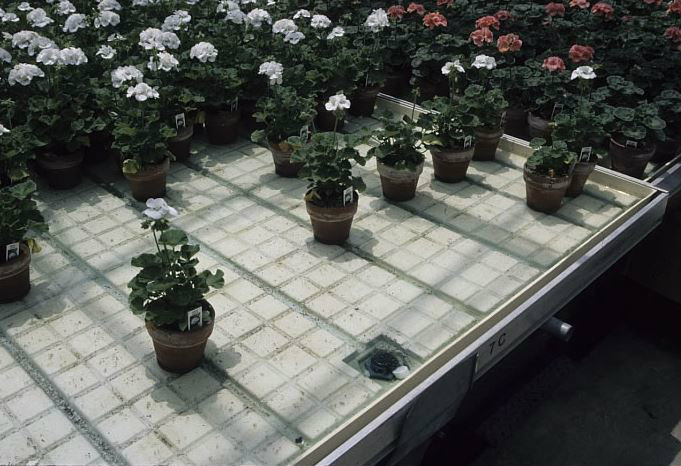What is Ebb and Flow Irrigation?
Ebb and Flow irrigation originated from the world of hydroponics. In the traditional hydroponic ebb and flow systems, containers are filled with a growing medium that is inert. The medium does not function like soil, meaning it is not part of the nutritional delivery process to the plants; it simply has the function of anchoring the roots and functions as a temporary reserve of water and solvent mineral nutrients. A fertilized solution alternately floods the system and proprietary valves on the flood trays allow the solution to drain at rates customized by the grower.
How Does Ebb and Flow Irrigation Work?
Ebb and Flow system work by intermittently flooding grow trays. Grow trays come in a variety of types. Trays exist that sit on top of greenhouse benches, or there are full commercial lines of ebb and flow benches (the entire benchtop itself is a tray or series of trays).
The trays are flooded with a nutrient solution that is pumped from a solution tank. The flooded tray drains the solution back into the solution tank but at a slower rate than it is filled, through the use of proprietary valves. This action is normally done with a submerged pump that is connected to a controller. When the controller turns the pump on, the nutrient solution is pumped into the grow tray. When the controller shuts the pump off, the nutrient solution flows back into the reservoir.
In order to prevent pathogen buildup, and to ensure that the fertilized solution continues to deliver the intended nutrients, it is essential to drain or purge the solution tanks on a schedule that fits your growing plan. Voeks Inc. provides design and installation for all types of purging systems that adhere to local water quality control board mandates.
Hydroponic Growing Method and Its Drawbacks
You can use ebb and flow systems in conjunction with traditional hydroponic growing practices. However, there are three things to keep in mind as far as drawbacks and limitations:
- The nutrient delivery process is 100% based on the fertigation solution
- Along with the growers understanding and maintenance of that solution
- Also, the solution will require stringent control of EC, temperature, PH, and nutrient concentration.
Flexibility with Soil-Less Media
Voeks Inc. in conjunction with growers has had success in designing and installing ebb and flow systems that do not fall within the typical structure of hydroponic growing practices.
Using soil-less media for example peat moss of different textures with a base nutrient charge allows incorporation of dry fertilizer. This growing practice can be planned and constructed to act as a back-up in regards to nutrient charge and buffering. This translates into needing not as perfect fertigation.
The Ideal Fertigation
For complete fertigation, there needs to be a redundancy of the combination. For example:
- a good peat-blend soil-less media,
- with a light dry fertilizer amendment,
- plus continuous liquid feed via low concentration
That redundancy can give flexibility to growers. So when, for example, your stock tanks runs out on a Saturday, the plants are fine until Monday because the soil is holding more nutrients.
This growing method does require however attention to design detail. Using relatively smaller particulate growing media needs to be managed by the implementation of plumbing, to prevent clogging of ebb and flow drains, and media buildup in solution tanks.
Contact Voeks, Inc. today for a free consultation about your commercial ebb and flow irrigation system.


